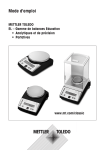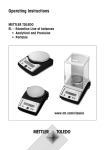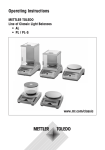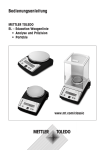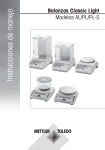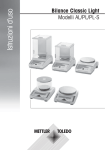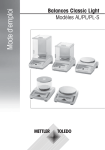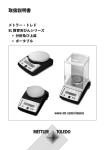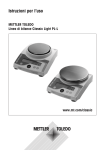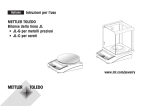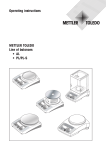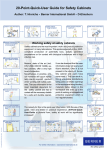Download Operating Instructions
Transcript
Operating Instructions METTLER TOLEDO EL – Education Line of balances • Analytical and Precision • Portable Operating instructions in a nutshell Press key briefly Press and hold key down until the desired display appears ▼ automatic sequence Recall weight / Recall weight value* 0.00 g Switching on On Free Newton factor / selectable display increment* 17.89 g 88888888 26.72 g ▼ 0.00 g F # # Switching off 0.00 g ▼ F * “ 26.72 g “ Simple weighing 0.00 g # # # 0.00 g # “ 12.07 g ▼ Cal ------ F StEPá ▼ Percent weighing* CAL int 9.8026 % SEt100 ▼ 0.01 0.02 … 1/10d Cal # ± Adjusting (calibration) internal 1.0009 0.00 g • 1182.03 g 1250.00 g 1.0000 … OFF Off # F FAC ŸÖ “ # 0.05 CAL donE ▼ ± % 100.00 # 0.00 g ± Adjusting (calibration) external Cal 101.60 175.35 % CAL ▼ Cal 2000.00 Taring 0.00 g Cal -----121.01 g ▼ Cal 0.00 # 0.00 g Cal ------ 95.97 g ▼ Cal CAL donE ▼ 0.00 g -121.01 g * These functions must be activated in the menu (section 4.3.2) Contents 3 Contents 1 Getting to know EL balances line .................4 1.1 General .............................................................. 4 1.2 Layout of balances ............................................... 4 1.3 Overview of key functions ...................................... 5 2 Startup ......................................................6 2.1 Unpacking / standard equipment............................ 6 2.2 Cautionary notes ................................................. 6 2.3 Setting up, leveling, preparations for weighing below the balance ......................................................... 6 2.4 Adjusting (calibration) .......................................... 8 3 Weighing ...................................................9 3.1 3.2 3.3 3.4 On/Off switching................................................... 9 Simple weighing .................................................. 9 Faster weighing with reduced readability ................. 9 Taring ................................................................. 9 4 Menu .......................................................10 4.1 Overview ........................................................... 10 4.2 Menu operation .................................................. 11 4.3 Description of menu options ................................ 11 5 Functions .................................................16 5.1 Recall weight / Recall weight value ....................... 16 5.2 Percent weighing................................................ 16 5.3 Weighing with free Newton factor and/or selectable display increments .............................. 17 6 Technical data, options, optional equipment ..................................19 6.1 6.2 6.3 6.4 6.5 Technical data ................................................... 19 RS232C interface ............................................... 21 MT-SICS Interface commands and functions .......... 22 Optional equipment ............................................ 24 Dimensional drawings (in mm) ........................... 25 7 Appendix .................................................26 7.1 Typical printouts from METTLER TOLEDO RS-P42 and LC-P45 printers ............................... 26 7.2 What if ...? ........................................................ 27 7.3 Maintenance and cleaning .................................. 28 7.4 Declaration of conformity .................................... 29 Getting to know EL balances line 4 1 Getting to know EL balances line 1.1 General Standard construction EL analytical EL precision Balance features • The EL balance line ranges from high-resolution analytical balances with a readability of 0.1 mg through to precision and portable balances with a readability of 0.001 g to 1 g. The weighing ranges extend from 120 g to 6.2 kg. • In addition to basic operations such as weighing, taring and adjusting (calibration) miscellaneous functions such as “Recall weight”, “Percent weighing”,or “Free Newton factor” can be activated. • Several EL balances are fitted with a glass draft shield in the factory; with other models a draft shield is available as an optional extra. Compact construction EL portable 1.2 Layout of balances 1 2 3 6 4 5 3 2 7 1 12 4 5 4 5 6 7 8 9 10 11 12 13 Keys Display Model plate with the following data: “Max”: maximum capacity “d”: readability Weighing pan Draft shield element (not on all models) Draft shield (supplied as standard with models with a readability of 0.1 mg and 1 mg) Leveling feet (not all models) Hanger opening for weighing below the balance (underside of balance) AC adapter socket RS232C interface (optional on EL portable) Lug for optional antitheft device Leveling control (not all models) Compartment for batteries (only in compact models) Keys and display are identical for all EL balances. 7 11 7 10 9 7 13 4 12 7 11 10 9 8 7 Getting to know EL balancees line 5 1.3 Overview of key functions The balances have two operator control levels: the weighing mode and the menu. The function of each individual key depends on the operator control level and how long the key is pressed. Key functions in weighing mode Weighing mode 0.000 g Press briefly Press and hold down 1/10d • Reduce readability Cal • Adjust (calibrate) On # C • Switch on • Zero/tare • Cancel function Off • Switch off “ • Switch • Change settings F • Call function; A function must be activated in the menu, otherwise “F nonE” appears in the display ± • Transfer weighing data via interface with activated printer • Confirm settings Menu • Show menu (hold key down until MENU appears) ▼ Key functions in menu mode Menu ŸÖENV Press briefly Press and hold down 1/10d • Change settings • Reduce value by 1 step 1/10d • Reduce value rapidly C • Close menu (without saving changes) “ • Change settings • Increase value by 1 step “ ± • Select next menu item Menu • Save changes and close menu – • Increase value rapidly Startup 6 2 Startup 2.1 Unpacking / standard equipment The standard equipment for every balance comprises: • AC adapter, to national standard • Weighing pan, Weighing pan support, draft shield element (depending on model) • Draft shield standard supply with models of 0.1 /1 mg readability (for other models available as an optional extra) • Operating Instructions • Protective cover 2.2 Cautionary notes • • • • EL balances must not be operated in hazardous areas with the standard-supply AC adapter. Before connecting the AC adapter, verify that the voltage printed on it corresponds to the local AC power supply voltage. If this is not the case, please contact your local METTLER TOLEDO dealer. EL balances may only be used indoors in a dry environment. For use with CSA Certified (or equivalent approved) power source, which must have a limited and SELV circuit output. 2.3 Setting up, leveling, preparations for weighing below the balance The optimum location The correct location makes an important contribution to the accuracy of the weighing results of high-resolution analytical and precision balances. • Stable, vibration-free position as horizontal as possible • No direct sunlight • No excessive temperature fluctuations • No drafts The best location is on a stable bench in a corner protected against drafts, as far away as possible from doors, windows, radiators or the louvers of air conditioners. Leveling Some models are equipped with a level glass and two or four leveling feet to compensate for minor irregularities in the surface on which the balance stands. The balance is exactly horizontal when the air bubble is in the middle of the level glass. Note: The balance should be leveled each time it is moved to a new location. Preparations for weighing below the balance To carry out weighing operations below the balance, get rid of the special cover on the underside of the balance. (Note: never put the balance without the protective cover over its cone down on its head, only on its side!). This exposes the opening for the hanger, making weighing below the balance possible. Startup 7 Antitheft device All models are provided with a lug for attaching an antitheft device (see optional equipment in Section 6.4). Power supply ➞ Plug the AC adapter into the AC adapter socket on the balance, and connect to the power supply. ➞ The balance performs a self-test. This test is finished when “OFF” appears. ➞ Press the «On» key briefly: the balance is in operational readiness. Before any work is performed with the balance, it must be adjusted (Section 2.4). Notes To achieve accurate results with analytical balances, they must be left switched on for at least 60 minutes to reach operating temperature before carrying out the first weighing operation. Battery operation (compact models only) Models in the compact line of balances can also be operated independently of the AC power supply by using their batteries. To do this, always fit the protective cover over the weighing cell cone first, then open the cover of the battery compartment on the underside of the balance and insert the batteries. Caution: ensure correct polarity (as specified inside the battery compartment). Close battery compartment again. When the balance is operating on its batteries, the border around the battery symbol in the display lights up. The number of segments that are lit is an indicator of battery condition (3 = fully charged, 0 = discharged). When the batteries are almost completely discharged, the last segment flashes. Recommended battery type: AA (LR6) 1.5 V alkali-manganese. NiMH (nickel-metal hydride) rechargeable batteries, which are recharged in an external battery charger, can be also be used. The intervals between recharging are not as long as the service life of a nonrechargeable battery. Notes • Batteries are not included in the standard supply. • Battery operation is automatically overridden when the AC adapter is connected to the AC power supply. • To prolong battery (disposable or rechargeable) life, it is advisable to activate «Auto shut» in the menu (see Section 4.3.7). • All discharged batteries must be disposed of in an environmentally responsible manner. No attempt must be made to incinerate or disassemble them. • Models with the standard construction cannot be operated with batteries. Startup 8 2.4 Adjusting (calibration) To obtain accurate weighing results, the balance must be adjusted to match the gravitational acceleration at its location. Adjusting is necessary • before the balance is used for the first time • at regular intervals during weighing service • after a change of location To obtain accurate results, the balance must be left switched on for 60 minutes to reach operating temperature before starting the adjustment procedure. Adjusting with internal weight (EL-IC models only) Cal CAL int ▼ Cal -----▼ Cal CAL donE ▼ 0.00 g ➞ To carry out this operation, in the second menu option (Adjustment) select “CAL int” (= factory setting) (section 4.1). ➞ Unload weighing pan. ➞ Press and hold the «Cal» key down until “CAL” appears in the display, then release key. ➞ The balance adjusts itself automatically. The adjusting is finished when the message «Cal done» appears briefly in the display, followed by “0.00 g”. The balance is again in weighing mode and ready for operation. Adjusting with external weight Cal CAL ▼ Cal 2000.00 Cal -----▼ Cal 0.00 Cal -----▼ Cal CAL donE ▼ 0.00 g ➞ Have required adjusting weight ready. ➞ Unload weighing pan. ➞ Press and hold the «Cal» key down until “CAL” appears in the display. Release key. The required adjustment weight value flashes in the display. ➞ Place adjustment weight in centre of pan. The balance adjusts itself auto-matically. ➞ When “0.00 g” flashes, remove adjustment weight. The adjusting is finished when the message “CAL done” appears briefly in the display, followed by “0.00 g”. The balance is again in weighing mode and ready for operation. Notes • This adjustment procedure can be terminated at any time with the «C» (“Cancel”) key. The balance reverts to weighing mode. Weighing 9 3 Weighing 3.1 On/Off switching On 88888888 ▼ Switching on ➞ Remove any load from weighing pan and press «On» key briefly. The balance performs a display test (all segments in the display light up briefly). When zero is displayed, the balance is ready for operation. 0.00 g OFF Off ▼ Switching off ➞ Press and hold the «Off» key down until “OFF” appears in the display. Release the key. 3.2 Simple weighing ➞ Place weighing sample on the weighing pan. 0.00 g ➞ Wait until the stability detector “•” disappears. • 1182.03 g 1250.00 g ➞ Read the result. 3.3 Faster weighing with reduced readability The balance has the facility for speeding up the weighing operation by reducing its readablity (number of decimal places): ➞ The balance is operating with its normal readability and speed. 1.24 g 1/10d 1.2 g ➞ Press the «1/10d» key and … ➞ … the balance operates with reduced readability (one decimal place less), but displays the weighing result quicker. Pressing the «1/10d» key briefly again toggles the balance back to its full readability. 3.4 Taring ➞ Place empty container on the balance. 0.00 g ➞ The weight is displayed. 121.01 g # 0.00 g 95.97 g -121.01 g ➞ Press the «#» key briefly. ➞ Add weighing sample to container. The net weight is now displayed. If the container is removed from the balance, the tare weight will be shown as a negative value. The tare weight remains stored until the «#» key is pressed again or the balance is switched off. 5) 4) 3) 2) 1) A.Off 5' A.Off - A.Off 2' A.Off 30" HS HArd HS SoFt 7b-no 8b-no 7b-odd bd 9600 bd 19200 bd 600 bd 1200 bd 4800 S. PÑÖ S. SICS S. Auto S. ALL S. Cont S. Stb S. oFF Factory setting Menu option ZDISPLAY HoSt PrintEr 9 Send mode 2) 5) no A.ZEro bd 2400 This menu option is only available on EL-IC models. This menu option is only shown if “Host” has been selected in menu option 8 (Peripheral unit). This menu option is only shown if “S.oFF” has not been selected in menu option 9 (Send mode). These menu options are only shown if “Host” or “Printer” has been selected in menu option 8 (Peripheral unit). Only displayed if an interface has been installed. Notes Unit 1 Unit 1 10 Send format 3) 5) dos A.Off 10' 7 Auto shut off 7b-E robust A.ZEro 6 Autozero HS OFF % kg g mg Unit 1 5 Weighing unit 1 8 Peripheral unit 5) F100 Std 4 Weighing mode 11 Baud rate 4) 5) F FAC ÑÖ # F nonE F rEcALL F FAC d # * 3 Function 12 Bit/Parity 4) 5) CAL E Cal CAL int Cal 2 Calibration 1) 13 Handshake 4) 5) LiST rESEt 1 Reset Overview of menu Menu 10 4 Menu In the menu you can change the weighing unit, select additional functions and carry out various settings. A description of the individual menu options is given in Section 4.3. 4.1 Overview Menu 11 4.2 Menu operation Opening the menu In weighing mode, press and hold down the «Menu» key until “MENU” appears in the display. Release the key: the 1st menu option is displayed. 0.01 g Menu ŸÖENU ▼ rESEt rESEt ± “ *F rEcALL *F rEcALL F 100 Menu Select menu options The «±» key is used to select individual menu options with their current settings one after the other. % StorEd Change settings Pressing the «“» key displays the next setting; pressing the «1/10d» key displays the previous one. Once the desired setting appears in the display, the next menu option can be selected («±») or you can close the menu (see following Section). Saving settings and closing the menu Hold the «Menu» key down until “StorEd” appears in the display. Release the key and the balance reverts to weighing mode. All changes are saved. 0.01 g C 0.01 g Abort Press the «C» key briefly. The balance reverts to weighing mode. Changes are not saved. Note If no entry is made within 45 seconds, the balance reverts to weighing mode. Changes are not saved. 4.3 Description of menu options 4.3.1 Reset or recording of balance settings (1st menu option “RESET”) Menu rESEt r donE Reset balance settings ➞ Select “Reset”, press and hold down the «Menu» key until the message “r donE” confirms that all menu settings have been reset. The balance then reverts to weighing mode and works with the factory settings (Section 4.1). 0.00 g “ rESEt LISt Menu StorEd 0.00 g Recording balance settings ➞ Select “List” and hold down the «Menu» key until the message “StorEd” is displayed. The current balance settings are transmitted to the peripheral device connected to the optional RS232C interface. To do this the setting “Printer” must always be selected at the 8th menu option (Peripheral unit). The current balance settings are saved at the same time. Menu 12 4.3.2 Adjustment (2nd menu option) (EL-IC models only) In this menu option you can select whether you wish to adjust the balances using the internal or the extternal adjustment weight: CAL int CAL E cal CAL int “ Adjusting with internal adjustment weight (factory setting) Adjusting with external adjustment weight cal CAL E 4.3.3 Functions (3rd menu option / see Section 5 for their use) In addition to simple weighing, the following functions can be selected with the «“» key: “ *F rEcALL F nonE F 100 # % F FAC ŸÖ # F rEcALL F nonE F 100 % F FAC M F FAC d Recall weighing No function, simple weighing Percent weighing Multiply free Newton factor value by weight, change size of display increment Divide free Newton factor value by weight, change size of display increment F FAC d 4.3.4 Weighing mode (4th menu option) Ö “ Ü Ñ Std doS robuSt This setting allows you to adapt the balance to the weighing mode. Select “Std” (standard) for all normal weighing processes. With “doS” (dosing) - for dispensing substances in liquid or powder form - the balance reacts very rapidly to the slightest changes of weight. With “robuSt” (absolute weighing) the balance only reacts to more significant changes in weight, so that the weighing result is very stable. Menu 13 4.3.5 Weighing unit 1 (5th menu option “UNIT 1”) Depending on requirements, the balance can operate with the following units: “ Unit 1 g Conversion factor 1 kg = 1000 g mg milligram 1 mg = 0,001 g … Unit 1 kg Unit g gram kg kilogram “ Comments factory setting not with 0.1 mg and 1 mg balances with 0.1 mg and 1 mg balances Unit 1 mg 4.3.6 Autozero (6th menu option / see overview and notes in Section 4.1) This menu option allows you to switch the automatic zero correction on or off. ÅZEro “ no ÅZEro Autozero switched on The zero point is automatically corrected (e.g. if drift occurs or the weighing pan becomes dirty). Autozero switched off The zero point is not automatically corrected. This setting is advantageous for special applications (e.g. evaporation measurements). 4.3.7 Auto shut off If the automatic shut off function is activated, the balance automatically switches itself off after a selected period of inactivity (i.e. with no key being pressed or changes of weight occurring): “ A.OFF 10é A.OFF A.OFF 30” A.OFF 2é A.OFF 5é A.OFF 10‘ A.OFF A.OFF 30“ A.OFF 2‘ A.OFF 5‘ Automatic shutoff after 10 minutes inactivity Automatic shutoff not activated Automatic shutoff after 30 seconds inactivity Automatic shutoff after 2 minutes inactivity Automatic shutoff after 5 minutes inactivity Menu 14 4.3.8 Peripheral unit (8th menu option / see overview and notes in Section 4.1) Peripheral devices can only be connected if the balance has been equipped with an RS232C interface. The balance automatically saves the appropriate settings (Sections 4.3.9 – 4.3.13) for every peripheral device. “ PrintEr Host Printer Host Aux. display Connected to a printer. Connection to any desired peripheral device. Connection of an optional auxiliary display unit (communications parameters cannot be selected). z.dISPLAY 4.3.9 Send mode (9th menu option / see overview and notes in Section 4.1) Note: This menu option is only available if the “Host” setting was selected in the 8th menu option (Peripheral unit)! It specifies how a value is transferred to a peripheral device. S. oFF Send mode switched off. S. oFF S. Stb The next possible stable value will be transferred after the «±» key “ has been pressed. S. Cont All values are transferred automatically. S. Stb S. Auto Only stable values are transferred automatically. S. .Cont S. All The current value is transferred after the «±» key has been pressed. S. Auto S. .ALL 4.3.10 Send format (10th menu option / see overview and notes in Section 4.1) Note: This menu option is only available if the “S. oFF” setting was not selected in the 9th menu option (“Send mode”)! It sets the data transfer format. S. .SICS “S. SICS”: The MT-SICS data transfer formats are used. Please refer to the “ “Reference Manual MT-SICS B-S/L/L-S balances 11780447”, available from your METTLER TOLEDO dealer or downloaded from S. .PŸÖ the Internet (www.mt.com/pl or www.mt.com/al see “Support”). More Information please find in the Section 6.3. “S. PM”*: The following PM balance data transfer formats are used: S. Stb: /////1.67890/g S. Cont: S////1.67890/g SD///1.39110/g S. Auto: S////1.67890/g S. All: /////1.67890/g /D///1.39110/g * unidirectional, no MT-SICS commands are accepted. Menu 15 4.3.11 Baud rate (11th menu option / see overview and notes in Section 4.1) “ bd 2400 “ … bd 4800 bd 19200 Note: This menu option is only available if the “Printer” or “Host” setting was selected in the 8th menu option (Peripheral unit)! The baud rate (data transfer rate) determines the speed of transmission via the serial interface. The unit is the baud (bd) = 1 bit/second. The following settings are available: 600 bd, 1200 bd, 2400 bd, 4800 bd, 9600 bd and 19200 bd. For problem-free data transmission the sending and receiving devices must be set at the same value. 4.3.12 Bit/Parity (12th menu option / see overview and notes in Section 4.1) Note: This menu option is only available if the “Printer” or “Host” setting was selected in the 8th menu option (Peripheral unit)! It sets the character format for the peripheral device connected to the balance. “ 7b-E 7b-no 7b–E 7b–no 8b–no 7b–odd 7 data bits/even parity 7 data bits/no parity 8 data bits/no parity 7 data bits/odd parity 8b-no 7b-odd 4.3.13 Handshake (13th menu option / see overview and notes in Section 4.1) Note: This menu option is only available if the “Printer” or “Host” setting was selected in the 8th menu option (Peripheral unit)! This function is used to select the data transfer mode to suit different serial devices. “ HS oFF HS SoFt HS HArd HS oFF HS SoFt HS HArd No handshake Software handshake (XON/XOFF) Hardware handshake (RTS/CTS) Functions 16 5 Functions Settings and values saved under a given function are retained until they are replaced or another function is selected. The «C» key can be used to cancel the procedure currently in progress. 5.1 Recall weight / Recall weight value Requirement The function “rEcALL” must be activated in the menu (Section 4). 0.00 g F # * 26.72 g ➞ Put weight on balance. Display shows weight value and stores stable value. 0.00 g ➞ Remove weight. When the weight is removed the Display shows zero. ➞ Press the «F» key briefly The display shows last stored stable weight value for 5 seconds together with asterisk (*) symbol. After 5 seconds or by pressing the «F» key briefly, the display goes back to zero. This can be repeated unlimited times. Every recalled value is marked with the asterisk (*) icon. 26.72 g Delete last weight value As soon a new stable weight value is displayed, the old value becomes replaced by the new weight value. ➞ When pressing the «#» key briefly, the stored value is set to 0 and normal tare is executed. Note: If the power is switched off, the stored value is permanently lost. 0.00 g 5.2 Percent weighing Requirement The function “F 100 %” must be activated in the menu (Section 4). 0.00 g 148.50 g F SEt100 % Set target weight ➞ Target weight (Reference weight, which corresponds to 100 %) in centre of pan. Note that the minimum weight = 10d (d: display increment). ➞ Hold the «F» key down until “SEt 100 %” is displayed. ± 100.00 % ➞ Press the «“» key to select “SEt 100 %” or “SEt no %” (Percent weighing deactivated). ➞ The «±» key can be used briefly to confirm or automatic acceptance after 7 seconds. Functions 17 101.60 “ 150.88 g “ 101.60 % Switching between percent weighing and weight display ➞ Place weighing sample in centre of pan. The weight of the sample is displayed as a percentage of the target weight. ➞ Press the «“» key. The weight is displayed. % ➞ Return to display in percent: pressing the «“» key again. 5.3 Weighing with free Newton factor and/or selectable display increments In this menu option a custom “free Newton factor” can be defined at will. The unit Newton measures the amount of force required to accelerate a mass of one kilogram at a rate of one meter per second squared. 1 N = 1 kg ∙ m/s2 The factor m/s2 is also called gravitational acceleration. Newton is dependant on the geographical location and height of the balance and its user - hence making it necessary to adjust the unit according to the precise location. In this menu option a custom “free Newton factor” can be defined at will. This value is then either multiplied (“F FAC M”) by the weighing result (in grams), i.e. reading = factor x weight, or it is divided (“F FAC d”) by the weight, i.e. reading = factor / weight. The range over which this factor can be selected depends on the weighing range and the readability of the model concerned. Location Berlin Brussels Cairo Guayaquil Helsinki Kuala Lumpur London Los Angeles Madrid Melbourne Miami Nairobi New York Oslo Paris Reykjavik Shanghai Singapur Tokyo Washington Gravity Acceleration 9.8127 9.8114 9.7932 9.7806 9.8190 9.7802 9.8120 9.7955 9.7996 9.7997 9.7903 9.7753 9.8026 9.8192 9.8093 9.8226 9.7941 9.7802 9.7979 9.8009 The ability to select the display increments makes it possible to specify how the weighing result is to be presented, the choice of display increments being limited by the set factor and the resolution of the balance model itself. Functions 18 Requirement The function “F FAC M” or “F FAC d” must be activated in the menu (Section 4). 17.89 g F # F FAC ŸÖ # # 1.0009 … “ 1.0000 “ ± # # 9.8026 StEPá ▼ # # 0.02 … “ 0.01 “ ± # # 0.05 175.35 Entering the free Newton factor and/or the display increments ➞ Hold the «F» key down until “F FAC M” or “F FAC d” appears in the display. ➞ Press the «“» key to select “FAC M” / “FAC d” or “noFAC M” / “noFAC d” (Function deactivated). ➞ Release the key. Either the factor 1 appears as default value or the factor that was saved most recently. This value can now be changed: ➞ Pressing the «“» key increases the factor. Pressing the «1/10d» key reduces the factor. Pressing the key once changes the value by one increment. If the key is held down, the value changes increasingly rapidly. ➞ Confirm the selected factor with the «±» key (it will not be saved automatically). “StEP=” appears in the display, and the program changes automatically to allow the display increments to be entered. The smallest possible display increment appears as default value, or the last value that was saved. ➞ This value can be changed in the same way as for the free Newton factor (see above). Confirm the selected display increment with the «±» key (it will not be saved automatically). The appropriate calculation is then made using the weight on the pan in grams and the selected factor, the result being displayed with the selected display increment. No units are displayed, the symbol “#” being displayed instead. The calculation is always based on the weight in grams. Note • If you only want to change the display increments, set the free factor at exactly 1. Toggling between displaying the calculated value and the measured weight ➞ Place the sample on the weighing pan. The appropriate calculation is then made using the weight of the sample and the selected factor, the result being displayed with the selected display increment. ➞ Press the «“» key. The weight is displayed. ➞ Press the «“» key again to return to the calculated value. Technical data, options, optional equipment 19 6 Technical data, options, optional equipment 6.1 Technical data Standard equipment of EL balances • AC adapter to national standard as per list in Section 6.4. AC Adapter input voltage tolerance ±10 % Balance power input 6-14,5VAC, 50/60Hz, 4VA or 7-20VDC, 4W • Draft shield (on models with 0.1 / 1 mg resolution) • All models can weigh below balance Materials • Housing base: standard construction: die-cast aluminum, painted compact construction: plastic (ABS/PC), painted • Top housing: standard construction: plastic (ABS/PC), painted compact construction: plastic (ABS/PC), painted • Weighing pan: 18/10 chromium-nickel steel Protection • Protected against dust and water • Pollution degree: 2 • Installation category: class II • EMC: see declaration of conformity Ambient conditions The technical data are valid under the following ambient conditions: • Ambient temperature 10 °C … 30 °C • Relative humidity 10 % to 80 % at 31 °C, linear decreasing to 50 % at 40 °C noncondensing Operability is assured at ambient temperatures between 5 and 40 ºC. Batteries (compact construction) • 4 x AA (LR6) 1.5 V alkali-manganese, typical 20 h (with 2.9 Ah capacity) Max. capacity Readability Repeatability (sd) Linearity Sensitivity temperature drift (10 °C … 30 °C) Settling time, typical Adjustment weight internal Adjustment weight external (optional) Interface RS-232C External dimensions of balance (W/D/H) in mm External dimensions of packaging (W/D/H) in mm Weighing pan Usable height of draft shield Net weight (with packaging) kg Level indicator Number of leveling screws Standard construction EL104 120 g 0.0001 g 0.0001 g 0.0002 g 2.5 ppm/°C EL204-IC 220 g 0.0001 g 0.0001 g 0.0002 g 2.5 ppm/°C EL204 220 g 0.0001 g 0.0001 g 0.0002 g 2.5 ppm/°C 4s no 100 g yes 4s yes 200 g yes 4s no 200 g yes 238x335x364 238x335x364 238x335x364 520x385x555 ø 90 mm 225 mm 5.8 (8.4) yes 2 520x385x555 ø 90 mm 225 mm 5.8 (8.4) yes 2 520x385x555 ø 90 mm 225 mm 5.8 (8.4) yes 2 Technical data, options, optional equipment 20 Max. capacity Readability Repeatability (sd) Linearity Sensitivity temperature drift (10 °C … 30 °C) Settling time, typical Adjustment weight internal Adjustment weight external (optional) Interface RS232C External dimensions of balance (W/D/H) in mm External dimensions of packaging (W/D/H) in mm Weighing pan Usable height of draft shield Net weight (with packaging) kg Level indicator Number of leveling screws Max. capacity Readability Repeatability (sd) Linearity Sensitivity temperature drift (10 °C … 30 °C) Settling time, typical Adjustment weight internal Adjustment weight external (optional) Interface RS232C External dimensions of balance (W/D/H) in mm External dimensions of packaging (W/D/H) in mm Weighing pan Net weight (with packaging) kg Level indicator Number of leveling screws Standard construction EL303-IC EL303 320 g 320 g 0.001 g 0.001 g 0.001 g 0.001 g 0.002 g 0.002 g 6 ppm/°C 6 ppm/°C EL3002-IC 3200 g 0.01 g 0.01 g 0.02 g 6 ppm/°C EL3002 3200 g 0.01 g 0.01 g 0.02 g 6 ppm/°C 3s yes 200 g yes 3s no 200 g yes 1.5 s yes 2000 g yes 1.5 s no 2000 g yes 238x335x287 238x335x287 238x335x111 238x335x111 520x385x555 ø 100 mm 150 mm 5.1 (7.9) yes 2 520x385x555 ø 100 mm 150 mm 5.1 (7.9) yes 2 520x385x360 ø 180 mm – 4 (6.4) yes 2 520x385x360 ø 180 mm – 4 (6.4) yes 2 Compact construction EL202 220 g 0.01 g 0.01 g 0.02 g 10 ppm/°C EL602 620 g 0.01 g 0.01 g 0.02 g 10 ppm/°C EL2001 2200 g 0.1 g 0.1 g 0.2 g 10 ppm/°C 1.5 s no 200 g optional 1.5 s no 500 g optional 1.5 s no 2000 g optional 194x225x67 194x225x67 194x225x67 350x275x140 ø 120 mm 350x275x140 ø 120 mm 350x275x140 ø 160 mm 1.0 (2.1) no – 1.2 (2.2) yes 4 1.3 (2.3) no – Technical data, options, optional equipment 21 Max. capacity Readability Repeatability (sd) Linearity Sensitivity temperature drift (10 °C … 30 °C) Settling time, typical Adjustment weight internal Adjustment weight external (optional) Interface RS232C External dimensions of balance (W/D/H) in mm External dimensions of packaging (W/D/H) in mm Weighing pan Net weight (with packaging) kg Level indicator Number of leveling screws Compact construction EL4001 4200 g 0.1 g 0.1 g 0.2 g 10 ppm/°C EL6001 6200 g 0.1 g 0.1 g 0.2 g 10 ppm/°C EL6000 6200 g 1g 1g 2g 10 ppm/°C 2s no 2000 g optional 2s no 5000 g optional 1s no 5000 g optional 194x225x67 194x225x67 194x225x67 350x275x140 ø 160 mm 1.3 (2.3) yes 4 350x275x140 ø 160 mm 1.3 (2.3) yes 4 350x275x140 ø 160 mm 1.3 (2.3) no – 6.2 RS232C interface DATA RxD TxD IN OUT GND 5 1 9 6 HAND SHAKE CTS RTS IN OUT Every balance can be equipped with an optional RS232C interface for connection to a peripheral device (e.g. printer, auxiliary display or PC with a 9-pin male connector, see Section 6.4). The balance must then configured to suit the peripheral device in a menu dialog (Sections 4.3.8 – 4.3.13). A detailed description of the available interface commands is given in the “Reference Manual MT-SICS B-S/L/L-S balances 11780447”. This can be downloaded from the Internet (www.mt.com/pl or www.mt.com/al see “Support”) and is only available in English. The wide range of features of the EL balances regarding documentation of the results can be utilized by connecting to a printer, e.g. the RS-P42 or LC-P45 from METTLER TOLEDO. Printed results then make a decisive contribution to simplifying GLP/GMPcompliant work. Technical data, options, optional equipment 22 6.3 MT-SICS Interface commands and functions Many of the balances used have to be capable of integration in a complex computer or data acquisition system. To enable you to integrate balances in your system in a simple manner and utilize their capabilities to the full, most balance functions are also available as appropriate commands via the data interface. All new METTLER TOLEDO balances launched on the market support the standardized command set “METTLER TOLEDO Standard Interface Command Set” (MT-SICS). The commands available depend on the functionality of the balance. Basic information on data interchange with the balance The balance receives commands from the system and acknowledges the command with an appropriate response. Command formats Commands sent to the balance comprise one or more characters of the ASCII character set. Here, the following must be noted: • Enter commands only in uppercase. • The possible parameters of the command must be separated from one another and from the command name by a space (ASCII 32 dec., in this description represented as /). • The possible input for “text” is a sequence of characters of the 8-bit ASCII character set from 32 dec to 255 dec. • Each command must be closed by CRLF (ASCII 13 dec., 10 dec.). The characters CRLF, which can be inputted using the Enter or Return key of most entry keypads, are not listed in this description, but it is essential they be included for communication with the balance. Example S – Send stable weight value Command S Response Send the current stable net weight value. S/S/WeightValue/Unit Current stable weight value in unit actually set under unit 1. Example Command Response S/I Command not executable (balance is currently executing another command, e.g. taring, or timeout as stability was not reached). S/+ Balance in overload range. S/- Balance in underload range. S Send a stable weight value. S/S/////100.00/g The current, stable weight value is 100.00 g. Technical data, options, optional equipment 23 The MT-SICS commands listed below is a selected list of available commands. For additional commands and further information please refer to the Reference Manual “MT-SICS for B-S/L/L-S balances 11780447” downloadable from the Internet under www. mt.com/pl or www.mt.com/al. S – Send stable weight value Command S Send the current stable net weight value. SI – Send value immediately Command SI Send the current net weight value, irrespective of balance stability. SIR – Send weight value immediately and repeat Command SIR Send the net weight values repeatedly, irrespective of balance stability. Z – Zero Command Z Zero the balance. @ – Reset Command @ Resets the balance to the condition found after switching on, but without a zero setting being performed. SR – Send weight value on weight change (Send and Repeat) Command SR Send the current stable weight value and then send continuously the stable weight value after every weight change. The weight change must be at least 12.5 % of the last stable weight value, minimum = 30d. ST – Send stable weight after pressing ± (transfer) key Command ST Inquiry of actual status of the ST function. SU – Send stable weight value with currently displayed unit Command SU As the “S” command, but with the currently displayed unit. Technical data, options, optional equipment 24 6.4 Optional equipment AC/AC adapters Output: 12 VAC, 500 mA • Euro 230V/50Hz/80mA • Euro/(grd) 230V/50Hz/80mA • UK 240V/50Hz/80mA • USA 120V/60Hz/10W • Japan 100V/50Hz/10W AC/DC adapters Output: 9VDC,1.0 A • Japan 100V/50Hz AC adapters universal (bench version) Output: 12 VAC, 1.0A • 220-240V/50Hz/100mA Output: 12 VDC, 2.25A • 100-240V / 50/60Hz/0.8A 11103740 11103744 11103742 11103741 11103743 12102324 11103745* 11132070* *(appropriate cable for country also required) AccuPac B-S Rechargeable external power source for 15 hours weighing operation independent of AC power supply 21254691 Adjustment weights Available as OIML weights (E1, E2, F1, 11795461 with calibration certificate); for further details see METTLER TOLEDO Weights brochure or see www.mt.com/weights Antitheft device Cable with lock (for all models) Auxiliary display 1) • Auxiliary display including RS cable and seperate AC adapter • Auxiliary display with switchbox 590101 224200 12120057 Density kit • For analytical balances (0.1 mg / 1 mg) 33360 Draft shields for compact models • Glass cylinder (see also weighing pan) • Round draft shield with sliding opening 12102988 12102505 Draft shield for standard models • For “mg” balances (150 mm) 12105346 Interface • RS232C The interface must be fitted in the factory. Retrofitting is only possible if carried out by a METTLER TOLEDO sevice facility. Interface cable 1) • RS9–RS25: (m/f), length 2 m • RS9–RS9: (m/f), length 1 m • RS9–RS9: (m/m), length 1 m • RS232–USB converter cable 11101052 11101051 21250066 11600610 In-use cover • Standard models • Compact models 12102970 12102980 Printer, Application printer (LC-P45) 1) Plain-paper printer, 24 characters, with additional functions (time, date, statistic, multiplier etc.) 229119 Printer, Report printer (RS-P42) 1) Plain-paper printer, 24 characters 229265 Software 1) LabX direct balance (software for easy data transfer to PC) Transport case • For all compact models (without draftshield); accomodates balance, AC adapter, batteries and weights 11120340 12102982 Weighing pan • Only for compact models with (standard) 12102987 ø 160 mm weighing pan: ø 120 mm weighing pan (+ pan holder + draftshield element for operation without a draft shield): necessary for use together with draft shield (12102988) 1) RS232 interface necessary Technical data, options, optional equipment 25 6.5 Dimensional drawings (in mm) EL precision (standard construction) 238 194 67 111 EL portable (compact construction) 335.2 224.4 335.2 238 238 287 150 225 364 EL analytical (standard construction) with “0,1” mg draft shield EL analytical (standard construction) with “mg” draft shield 335.2 Appendix 26 7 Appendix 7.1 Typical printouts from METTLER TOLEDO RS-P42 and LC-P45 printers Function: Adjusting -BALANCE CALIBRATIONDate: ................ Time: ................ METTLER TOLEDO Type: EL3002 SNR: 1120053108 SW: 1.0 Weight ID: ............ Weight: 2000.00 g External Cal. done Signature: ........................ --------- END --------- Function: Percent weighing ----- % - WEIGHING ----Ref. 10.008 g 100.00 % 60.01 g 599.59 % Function: Free factor - FREE FACTOR WEIGHING Formula: factor * weight Factor: 12.73 Step: 0.01 49.94 # Function: List Printout of the current balance settings --- LIST OF SETTINGS --Date: ................. Time: ................. METTLER TOLEDO Type: EL602 SNR: 1120053108 SW: 1.0 TDNR: 7.17.1.286.108 -----------------------Weighing Parameters: Weighing Mode Standard Unit 1 g A.Zero On -----------------------System Parameters: Auto off 10 min -----------------------Peripheral Devices: P.Device Printer Baud 2400 Bit/Parity 7b-even Handshake Off P.Device Host Sendmode Off Baud 9600 Bit/Parity 8b-no Handshake Soft --------- END ---------- Function: Multiplier Only possible with LC-P45. Function is triggered via the printer. 04.07.2002 ID SNR: Factor * 08:23:22 242 1118015657 1.65 588.43 g 970.9095 Function: Verification of the calibration (adjustment) with external weight. Only possible with LC-P45. Function is triggered via the printer. ----- BALANCE TEST ----04.07.2002 09:52:12 METTLER TOLEDO Type: EL3002 SNR: 1120053108 SW: 1.0 Weight ID: ............. Target : ............... Actual : .......199.98 g Diff : ............... External test done Signature: ........................ --------- END ---------- Function: Statistics Only possible with LC-P45. Function is triggered via the printer. 04.07.2002 10:44:07 ID 666 SNR: 1118015657 1 1100.15 g 2 1600.10 g 3 1699.95 g n 3 x 1466.733 g s 321.372 g srel 21.91 % min. 1100.15 g max. 1699.95 g dif. 599.80 g --------- END ---------- Notes With the RS-P42 the date and time must be entered by hand at the top of the report (see specimen printout for the “Adjusting” function). With the LC-P45 the date and time are recorded automatically (see specimen printout for the “Statistics” function). The operating instructions for the LC-P45 include a description of the functions that are triggered via that printer. The RS-P42 prints all reports in English. This applies also to the LC-P45 reports that originate in the balance. In the case of reports triggered by the LC-P45, the following languages may be selected: German, English, French, Spanish or Italian. Appendix 27 7.2 What if ...? Error/Error message Cause Rectification íååååì Overload ➞ Remove sample from weighing pan, zero again (tare). î____ï Underload ➞ Check whether weighing pan is positioned properly. Error 1 No stability • in taring or adjusting (calibration) Error 2 Wrong adjustment weight on pan or none at all ➞ Place required adjustment weight in centre of pan. Error 3 Reference weight (Percent weighing) too small ➞ Increase reference weight. Error 4 Internal fault ➞ Contact METTLER TOLEDO customer service. Wrong weighing pan or pan missing or not empty ➞ Place correct pan or empty pan on balance. 0.000 g Abort ➞ Wait for stability before pressing key. ➞ Ensure more stable ambient conditions. ➞ Remove weighing pan and clean if necessary Adjustment aborted with the «C» key No display • AC adapter not plugged in • Batteries discharged (only with compact models) ➞ Check AC power supply. Plug AC adapter into power supply. ➞ Replace batteries Appendix 28 7.3 Maintenance and cleaning Service Regular servicing of your balance by a service technician prolongs its working life. Ask your METTLER TOLEDO dealer for details of servicing options. Cleaning Every now and then, clean the weighing pan, draftshield element, draftshield (depending on the model) and housing of your balance using a damp cloth. Your balance is made of high-quality, durable materials and can therefore be cleaned with a standard, mild cleaning agent. Please observe the following notes • On no account use cleaning agents, which contain solvents or abrasive ingredients, as this can result in damage to the terminal overlay. • After working with chemicals, it is advisable to wash or clean the weighing pan and the bottom plate (if draft shield fitted). • Although all materials are of high quality, corrosion may occur if corrosive substances are deposited on chrome steel for an extended period of time (and if air is excluded, for example by a coating of grease). • Ensure that no liquid comes into contact with the balance or the AC adapter! • Never open the balance or AC adapter – they contain no components, which can be cleaned, repaired or replaced by the user. • Soiled protective covers can be replaced on all balance types (see Optional equipment). Disposal In conformance with the European Directive 2002/96/EC on Waste Electrical and Electronic Equipment (WEEE) this device may not be disposed of in domestic waste. This also applies to countries outside the EU, per their specific requirements. Please dispose of this product in accordance with local regulations at the collecting point specified for electrical and electronic equipment. If you have any questions, please contact the responsible authority or the distributor from which you purchased this device. Should this device be passed on to other parties (for private or professional use), the content of this regulation must also be related. Thank you for your contribution to environmental protection. Appendix 29 7.4 Declaration of conformity The undersigned declare on behalf of Mettler-Toledo GmbH Im Langacher CH-8606 Greifensee that the balances METTLER TOLEDO EL… / EL…-IC to which this declaration relates (serial number specified on the product) are in compliance with the below mentioned EEC Directives (including all amendments) 73/23/EEC Low Voltage Directive 89/336/EEC Electromagnetic compatibility and that following standards have been applied IEC/EN61010-1:2001, EN61326:1997+ A1:98+A2:01+A3:03 (class B) EN61326:1997+ A1:98+A2:01+A3:03 (Minimal requirements) for Canada, USA and Australia CAN/CSA-C22.2 No.61010-1-04, UL Std. No.61010A-1, FCC, Part 15, class A, AS/NZS CISPR 22, AS/NZS 61000.4.3 Greifensee, 05.05.2006 Mettler-Toledo GmbH Laboratory & Weighing Technologies René Lenggenhager General Manager Sascha von Wangenheim Manager Sales & Marketing Leer Leer To protect your METTLER TOLEDO product’s future: METTLER TOLEDO Service assures the quality, measuring accuracy and preservation of value of all METTLER TOLEDO products for years to come. Please send for full details about our attractive terms of service. Thank you. *P11780854* Subject to technical changes and to the availability of the accessories supplied with the instruments. © Mettler-Toledo GmbH 2006 11780854 Printed in Switzerland 0605/2.12 Mettler-Toledo GmbH, Laboratory & Weighing Technologies, CH-8606 Greifensee, Switzerland Phone +41-44-944 22 11, Fax +41-44-944 30 60, Internet: http://www.mt.com
































